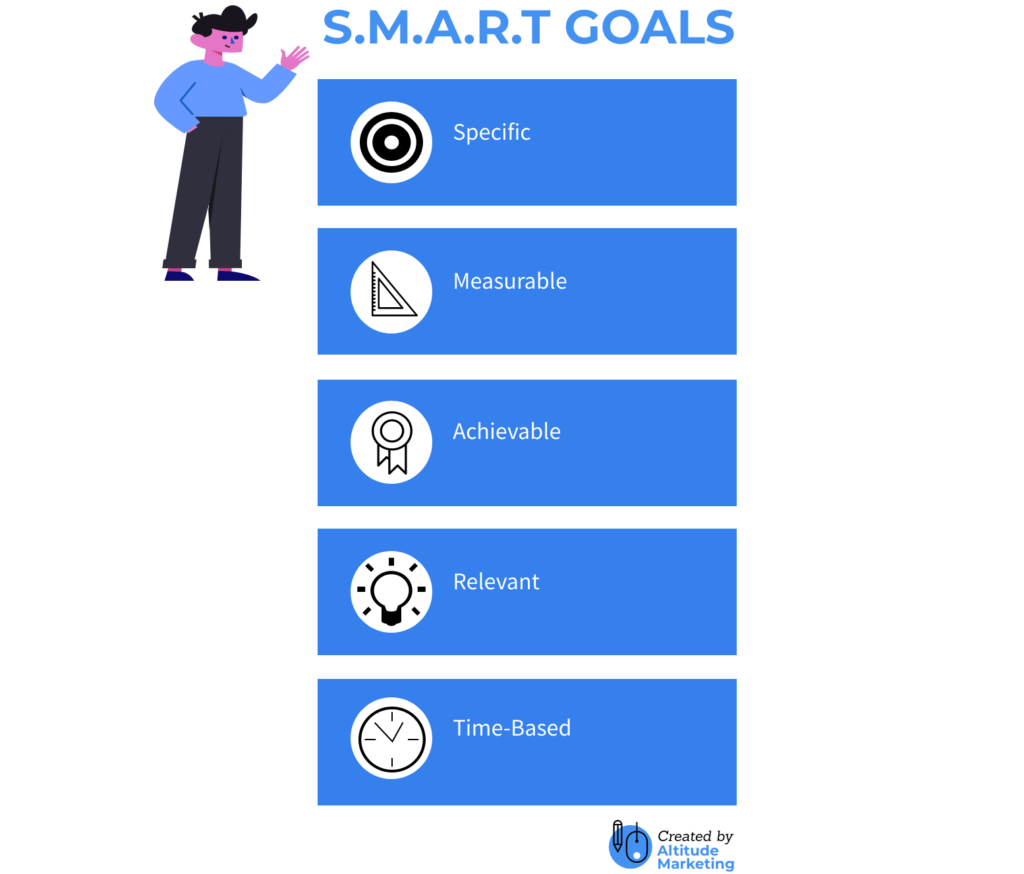In this data-driven world, it’s a given that you need to set marketing goals. After all, if you don’t know what target you’re shooting at, you’re usually going to miss.
But it’s one thing to say you need to set hard-and-fast B2B marketing goals. It’s quite another to sit around a whiteboard and actually try to articulate them.
That’s why goal-setting frameworks are so important. They help marketers break down their vision into actionable chunks, and develop the steps to get there.
A goal-setting framework for marketing. That means a S.M.A.R.T. goal, right?
Right?
Well, sometimes.
Usually.
But S.M.A.R.T. goals aren’t the only ones useful for B2B marketing. They absolutely have their merits, but they could use some backup.
But before we get there, let’s get S.M.A.R.T.

What Are S.M.A.R.T. Goals?
S.M.A.R.T goals have been around for quite a while. In fact, many accept them as the only way to do goal-setting.
Here’s what each piece stands for:

S: Specific
We’re talking real numbers and real deadlines.
It’s not “I want more visitors to my website.” It’s “I want to increase traffic to my website by 5% per month, which equals 2,000 weekly visitors by the end of December”. That’s a number-based goal. A specific goal.
M: Measurable
You need to be able to track your goals. You can’t just say “Give me better engagement on social media,” because that can’t really be measured. At least not 100%.
That’s where tracking website traffic comes in. Where Google Analytics comes in. That’s all measurable stuff.
A: Achievable
You don’t want to set a goal for something that is insane. That’s a given.
If you’re a million-dollar company, your S.M.A.R.T goal probably isn’t to be a hundred million dollar company by the end of the year.
So before you set your S.M.A.R.T goals, make sure you ask yourself: Is this in my power to do? Remember, you can’t base a S.M.A.R.T goal on sheer luck.
R: Relevant
Another given, we know. But you have to make sure your goals align with the big picture.
And don’t just set goals just for the sake of setting them. Make sure they’re worthwhile and line up with your other goals, too.
T: Time-Based
It’s not enough to say in your S.M.A.R.T goal framework that you want to be the most amazing company that ever existed. You have to do something that you can actually measure by a set date.
If you don’t have an end point, it’s going to drag. So put a deadline on it.
The Downside to Only Using S.M.A.R.T Goals
A lot of folks may absolutely recoil if you’re not using a S.M.A.R.T goal – and I mean, we get it. They force you into specific things. You know exactly what you’re going for and it gives you a time to get there by.
They’re super structured. And people like that.
But there is a downside to only using S.M.A.R.T goals in your B2B marketing goal-setting. They doesn’t necessarily allow for the creativity and spontaneity that can drive the best campaigns.
Take the pandemic. Every S.M.A.R.T goal that Zoom set for 2020 probably had to be thrown out the window. All of a sudden – and over and over again – S.M.A.R.T. goals became untenable.
Similarly, think about something inherently impossible to measure. Say you want your company to become “synonymous” with a particular methodology. Specific, sure. Relevant, absolutely. But not measurable … and maybe not achievable.
We repeat: Goal-setting is not bad. In fact, it’s incredibly important. But marketers need a goal-setting framework that allows them to adapt quickly. To fire a moonshot. To dream.
That’s why we like to informally layer D.U.M.B. goals on top of S.M.A.R.T. goals. They’re opposites, but together they become quite attractive.
D.U.M.B. Goals
Before we dive into D.U.M.B. goals, it’s important to reiterate that we don’t expect you to use them as a standalone framework.
If S.M.A.R.T goals are a hot dog, D.U.M.B. goals are the mustard. They’re best when you use them together.
(Who eats mustard on its own, anyway?!)
Remember, there are fuzzier things out there that may not be explainable by a S.M.A.R.T. goal alone.
Like things that don’t even exist yet.
And if you don’t know how to get to a certain point in your industry but want to figure out a way to get there, that’s where D.U.M.B. goals come in.
This is the visionary stuff. The dream stuff that leads to breakthroughs.
And the bigger picture futuristic thinking that can ultimately lead to bigger and better things for your company.
Sounds good, doesn’t it?
There are two reasons to get on the D.U.M.B. goals train that you should think about when adding them to your current B2B marketing goal-setting framework.
D: Dream-Driven
This is all about vision. If the S.M.A.R.T goal is the specific thing that you need to do that you can put your finger on, the D.U.M.B. goal is the opposite of that.
It’s the vision. The thing you can’t really quantify, but know you want. They by nature lack the specificity and sometimes even achievability demanded by S.M.A.R.T.
What they represent, by contrast, is the thing that – if achieved – changes the company, the industry … and maybe even the world.
Think big with D.U.M.B. Lay out the steps with S.M.A.R.T.
U: Uplifting
D.U.M.B. goals are about positivity. They help create a shared culture of “awesome” for your team.
Now, they can’t come totally out of nowhere. But if it’s even remotely possible or feasible to create a method to reach your goals, D.U.M.B. goals are the perfect accompaniment to your S.M.A.R.T. goals.
Take flying cars, for example. They’re uplifting – literally – but they’re a long way off. Thus, “create flying car” fails a lot of S.M.A.R.T. goal criteria. Developing a particular piece of technology that helps get you 1% of the way there, though, can be S.M.A.R.T. Remember – supplemental, and big picture.
M: Method-Friendly
If your goal doesn’t fit neatly into your day-to-day, it’s going to be forgotten. In other words, your moonshot needs to be about further, not just different.
If you don’t have systems and practices in place to drive you toward that dream – within the context of S.M.A.R.T. goals – it’s probably not going to happen. If your methods don’t jive with the desired end state, you have the wrong desired end state … or maybe the wrong methods.
B: Behavior-Triggered
This really speaks to staying on top of it.
When using a B2B marketing goal-setting framework, it’s easy to get into the weeds and focus on the micro, rather than the macro. You dive into the means, without respect to the end.
D.U.M.B. goals force you to to build in behaviors that will keep you looking and thinking about the vision. They’ll keep you on task and motivate you to keep going with it.
Is, for instance, a 5% increase in web traffic by the end of the year really about a 5% increase in web traffic?
No. It’s not. It’s about growing the top line to fuel innovation, growth and disruption.
Which equals a better company.
Better profitability.
And maybe even a better world.
tl;dr: Goal-Setting for B2B Marketing
There are two frameworks for B2B marketing goal-setting. And they’re basically the exact opposite of each other.
But opposites attract, right?
Just like S.M.A.R.T and D.U.M.B. goals do.
Sometimes the best stuff that we do comes from creativity, innovation, and honestly, a slightly weird place that can’t all be quantified in S.M.A.R.T goals.
Likewise, it can’t all be big picture. You need tactical and incremental pieces to measure your progress.
But when you put them together, it can create some pretty amazing stuff.
So don’t be dumb — be S.M.A.R.T and D.U.M.B.



